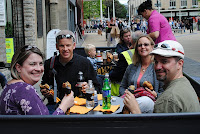Bristol was an extremely important city in the ministries of the Wesley brothers. George Whitfield, one of the members of the Holy Club at Oxford, invited John Wesley to Bristol to preach to the miners outside the town. This was where Wesley got his first taste of open air preaching. Wesley made Bristol one of his bases of operation in England, establishing the New Room as a kind of meeting house and outreach center in 1739. He had it built with quarters on the top floor that served to house himself as well as Charles and other traveling preachers. Records show that Wesley spent 1,500 nights here, more than any other place in his ministry, even London.
The New Room is now right in the heart of city shopping and you entered from the south side in between restaurants and on the north side next to a nail salon. On the south side, you enter through a garden past a statue of Wesley.
The sayings around the base of Wesley's statue are all famous quotes of his: 1) "I look upon all the world as my parish" (journal, June 1739)
2) "An ounce of love is worth a pound of knowledge" (letter to a teacher at Kingswood school, 1768)
3) "To invite, to convince, to offer Christ, to build up, and to do this in some measure in every sermon" (minutes of first Methodist conference, 1744)
4) "The best of all is that God is with us" (final words, March 1791)
We were guided through the New Room proper and got the opportunity to stand in the double pulpit. This was the pulpit from which John Wesley preached against slavery - a bold move considering at that time much of Bristol's wealth as a city depended upon the slave trade; its seaport was the entry port for most slaves into England.



Just a few blocks away in what is now a park on the outskirts of the old St. James church, we visited the grave of five of Charles Wesley's eight children.
We continued our walking tour as we headed over to the home that Charles and his wife Sally shared with their three surviving children. Their two sons were both extremely gifted and talented musicians. We viewed a replica of their harpsichord as well as Charles' study and his own inkwell used to pen over 6,500 hymns.
We walked back to the New Room in time to join the Friday afternoon communion service at 1pm. What a privilege to break bread and participate in the sacrament together, kneeling at the rail around the altar. What impressed us the most about Wesley's establishment of the New Room was that he intended for it to be a place of worship (but on Sunday evening, not in competition with morning Anglican services) as well as a place of community outreach. Within its walls, people were provided job training, educated for free, and provided basic medical care.
We were on our own for lunch, but everyone ended up at the same restaurant next to the New Room, West Cornwall Pasty Company. It was delicious - a pasty is basically a pot roast with potatoes and carrots and onions wrapped in a thick pastry shell.





































No comments:
Post a Comment